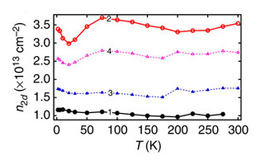Research Abstract
表面の極性吸着物質を用いた酸化物ヘテロ界面における電子伝導の制御
Control of electronic conduction at an oxide heterointerface using surface polar adsorbates
2011年10月11日 Nature Communications 2 : 494 doi: 10.1038/ncomms1501

導電性を示すLaAlO3とSrTiO3の界面には、さまざまな興味深い特性があり、特に、LaAlO3の表面状態とSrTiO3に埋められた界面の導電性の間には強い結合があるとされている。今回我々は、実験室でよく使われるさまざまな溶媒の表面吸着が、LaAlO3とSrTiO3の界面導電性に与える影響を調べた。アセトン、エタノール、水などを加えると導電率が大きく変化し、特にLaAlO3層の臨界膜厚付近で界面が絶縁体から金属的伝導へと転移を起こした。この現象は極性溶媒でのみ観察されることから、表面–界面間の電子移動メカニズムを考察する上で表面分極が重要な役割を果たしている実験的証拠を得ることができた。
- 東京大学大学院 新領域創成科学研究科
- スタンフォード大学(米国)
The interface between LaAlO3 and SrTiO3 possesses a range of intriguing properties, notably a proposed connection between the surface state of the LaAlO3 and the conductivity buried in the SrTiO3. Here we study the effect of the surface adsorption of a variety of common laboratory solvents on the conductivity at the interface between LaAlO3 and SrTiO3. We show that the application of chemicals such as acetone, ethanol, and water can induce a large change in the conductivity, and, in particular, an insulator to metal transition around the critical LaAlO3 thickness. This phenomenon is observed only for polar solvents. These data provide experimental evidence for a general polarization-facilitated electronic transfer mechanism.

